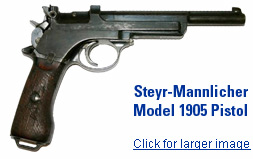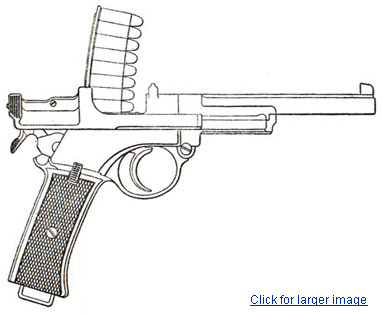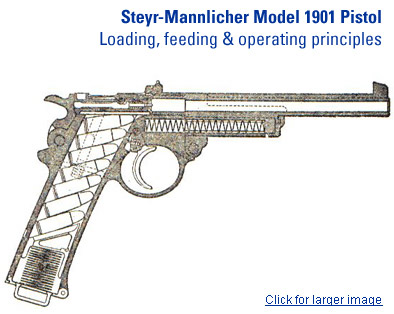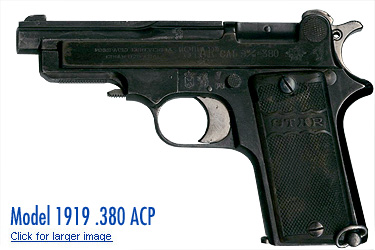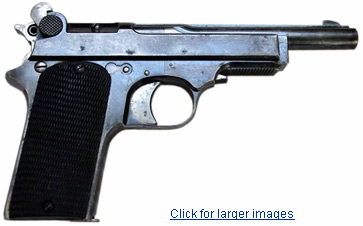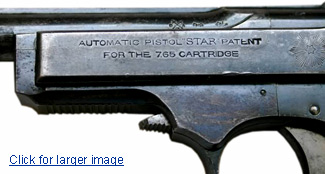Star Firearms — Mannlicher-Style Pistols
Early Bonifacio Echeverria pistols (they would not be sold under the Star trade name for some years) were based on the Steyr-Mannlicher Models 1900, to include the 1905. The first Echeverria pistols of which I am aware already were not truly clones, but already showed some innovation in having a more conventional pistol grip, and being fed from a removable box magazine in the butt, unlike the Mannlichers which were loaded thru the top with strippers.
The magazine release is a conventional button, of dog-bone configuration on the opposite side, but up almost to the slide on the left side rear of the trigger where the safety lever would later move for most vest-pocket pistols. The safety was initially a lever on the right side which rotated about the right cocking serration panel; when engaged, it somewhat obstructs the view across the sights, helping inform the user that the gun will not fire.
The Izarra "Ruby" styled French contract pistols are atypical of Echeverria pistols of this era. They are addressed in detail on another page. Please do not confuse the Izarra French contract pistols with the Model 1914 French service pistol, discussed below.
Please note that many of these early Star pistols were not all even called Stars. The company began using the Izarra ('star' in spanish) trade name irregularly until about 1920, when pistols with the Star trade name and logo began to appear.
Manuals & Disassembly Instructions
I do not have manuals for every pistol shown on this site. However, in many cases there is a related manual. Partly to make the series relationships clearer, and partly to assist with speed and accuracy of updating, all manuals can be found in one place, the manuals page. All manuals available are provided as downloadable PDFs, or you may purchase a printed copy of the entire set of handgun manuals.
There are, as yet, no manuals for any firearms from the Mannlicher-styled series.
No. 1
I have never specifically heard of a Bonifacio Echeverria No. 1 pistol, and am only surmising it. If there is a number 2, there has to be a number 1. Though it may be only a number assigned to engineering drawings, Star did not later seem to do this, so I speculate it was actually manufactured, if not produced and sold. I presume it to be a straight-up Mannlicher clone at least to get their feet wet. Top-loading and all. But I don't know for sure right now so do not quote me on that.
No. 2
First version
Though I have no photos, this is reported to be a Mannlicher clone, almost completely, but there are differences. The hammer is hidden (or possibly a striker) and the magazine is of what we today consider the conventional style consisting of a steel box removable from the bottom. Bonifacio also added a removable breechblock. To what end is not discussed. This may have been to encourage caliber changes (simply changing the breechface and barrel could allow users to change calibers) but does not seem to have been carried thru.
Second version
Production of the second version of the No. 2 began in 1906 also. It seems to have varied only in that the breechblock is now machined integrallly with slide.
Both of the Number 2 variants were produced until 1909.
1906
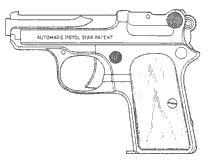
A smaller version with an exposed rowel (rounded or "commander" style) hammer, and generally becoming more and more what we today consider to be of conventional pistol layout.
This pistol began to be small enough to be considered a pocket, or vest-pocket pistol, something the Mannlicher was woefully incapable of being. This was an important segment of the commercial market. For whatever reason (fashion? convenience?) pistols in this era were generally not worn in holsters of any sort by civilized people, as opposed to soldiers or cowboys. Instead, they were carried in the pockets of ones' coat or in the purse or handbag. This necessitated a very small and lightweight pistol, often with no regard to caliber or power. The smallest of these were theoretically capable of fitting neatly in the vest pocket, hence the name, though this seems uncommon in practice.
1908
The modifications carried out to make the model 1906 more shootable, and easier to manufacture, were continued. The model 1908 is essentially a more full-sized version of the 1906.
1910 & 1913
I have no information on these pistols, but they are reportedly substantially model 1908 pistols in .32 ACP.
Model 1914, Model 1 Militar or Pistolet automatique, type Star
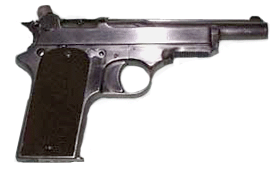
Though I had always thought the Model 1914 was simply a commercial version of the Model 1 Militar "Ruby" pistols, I am informed by a reader who owns one, that its still a Mannlicher style in keeping with the previous year-model numbered Echeverria pistols. There is also a chance that although the descriptions of these two pistols are correct, that my designations are still incorrect, and the Model 1 Militar was a Mannlicher style pistol, while the Ruby style contract gun had some other designation.
The reason for this extra confusion is that quantities of the Model 1914 were accepted for French military service. I am unclear in what quantities, but clearly significant numbers as there are specialized officers versions (with engraved slides), versions with and without the lanyard ring and so on. There is also more compact 7-shot officers model which is very prized in French gun collection circles today. These are illustrated and discussed in some detail in the recent "French Service Handguns" (Tommygun Books, Eugene Medlin and Jean Huon), which I have not seen, but should probably buy.
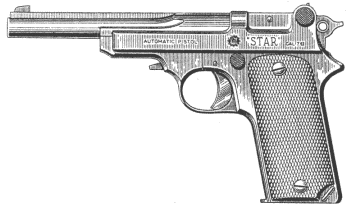
These pistols were definately made in .32 ACP caliber, but some reports indicate .25 caliber versions although this may simply be mis-identification of the similar, smaller, .25 ACP caliber model 1919. All these pistols vary from the previous Mannlicher-style models (the No. 2, 1906 and '08) in having an additional hammer-blocking drop safety.
These pistols seem to mark the first use of the Star trade name. This would coincide with the use of the Spanish "Izarra" for the French contract Ruby clones. I am sure there is something to be made of this, but not exactly sure what. Some reports also indicate that the company also registered "Estrella" (French for star) but they do not seem to have used it, like on the French pistols.
Reportedly, Bonifaco had originally planned on producing a still more improved version of the model 1914, initially to meet a French follow-on contract for 50,000 pistols. However, the end of their war resulted in the cancelation of the contract, and Echeverria decided that clones of the Colt 1911 were more commercially viable.
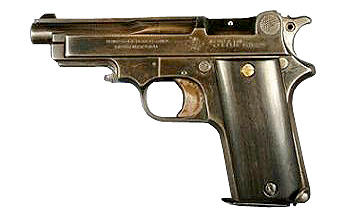
1919 Police ("Model Sindicalista")
The Model 1919 is essentially a somewhat more compact version of the 1914, returning as Star does many times over the decades to their roots as a maker o pocket pistols. The "police" designation for compact pistols, or compact versions of existing arms, has been common throughout Europe until the past decade or so. They were also of generally very low power; this would have been a completely typical police pistol of the era, but I have no idea if any were actually used by any police forces.
These were sold commercially, and achieved some measure of success in Spain. They became somewhat notorious for their use by radical union activists and anarchists ("sindicalists"). A story – possibly apocryphal – associated with this pistol the method of carry by these radicals: The pistol would be secured to a length of string, tied to the user's beltline and passing through a trouser pocket whose bottom was cut away. The pistol would be carried about ankle height, evading casual inspection by the police, but could supposedly be retrieved by pulling on the string to bring it back up to waist level.
It is not clear to me in which calibers this particular pistol was made. While many refer to it in .32 ACP (7.65 mm) this seems to be confusing the 1919 with the preceeding series. Others only refer to .25 ACP (6.35 mm) but the pistol shown here is distinctly a model 1919, and is clearly marked as a .380 ACP (9mm Browning Short, et. al.)
The markings on this particular pistol are also interesting. Aside from the .380 being relatively rare (and unheard of in police use compared to the .32) is should always in this era have been referred to by one of its "9 mm" designations. The .380 mark on the slide indicates it may have been for export sales (to the US?) or for some specific contract.
1920
Similar to the 1914 & 1919, made in both in .25 and .32 ACP calibers, and with at least two barrel lengths. It is also likely that some of the pistols identified as model 1919s, as above, are actually simply short barreled 1920 pistols.
Note that this pistol is distinctly labeled "Star" and even has the distinctive radial line star logo used for small area stamping until the end.
1921
A model only produced in .32 caliber. I have no further definitive details as yet, but presume it to be of the same general configuration as other pistols on this page, due to the time period. It may simply be an additional barrel length or caliber offered over the 1919 or 1920 pistols, but this is pure speculation as yet.
1926
Despite significantly overlapping the change in direction to 1911-style pistols, this is still a simple modification of the Mannlicher-derived 1914 pistol. However, it makes some changes to support to ergonomic style of the modern pistols, such as moving the safety to the conventional thumb-actuated position, instead of behind the trigger. Perhaps this is what the improved model 1914 for the French contract would have been, and the direction Star might have moved if not for the end of the war.
